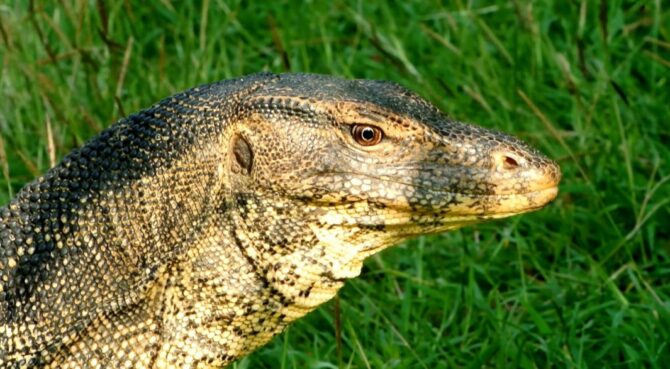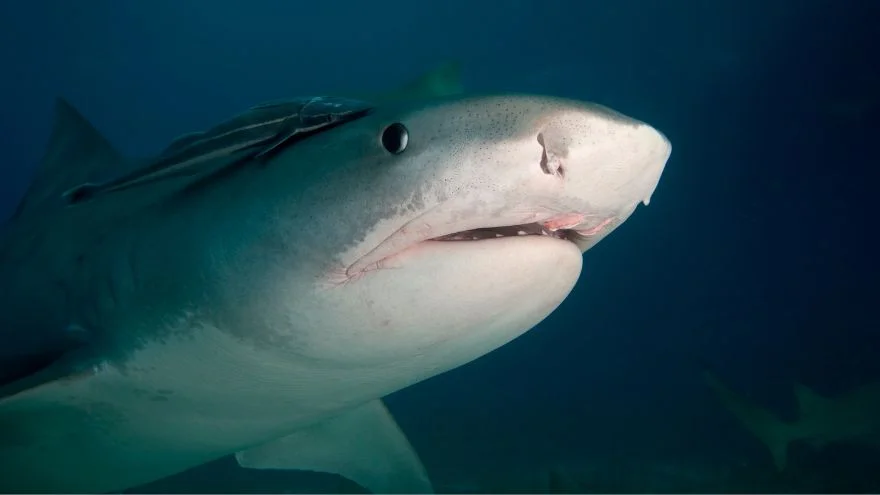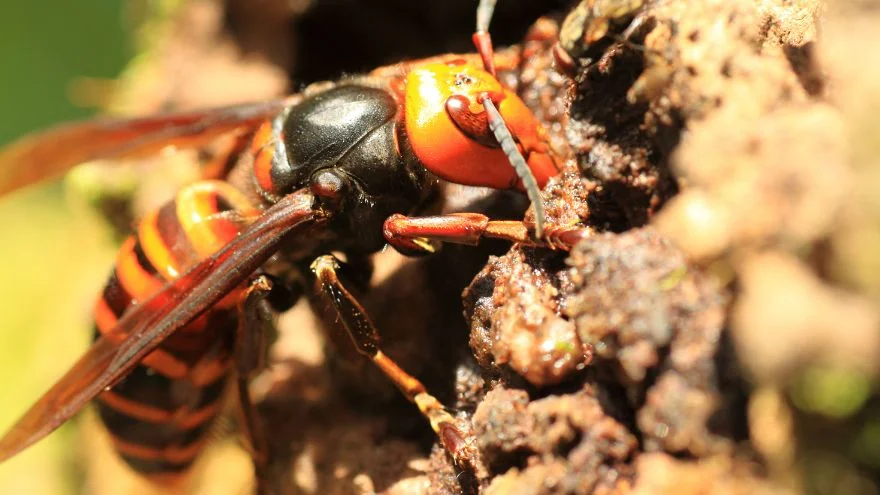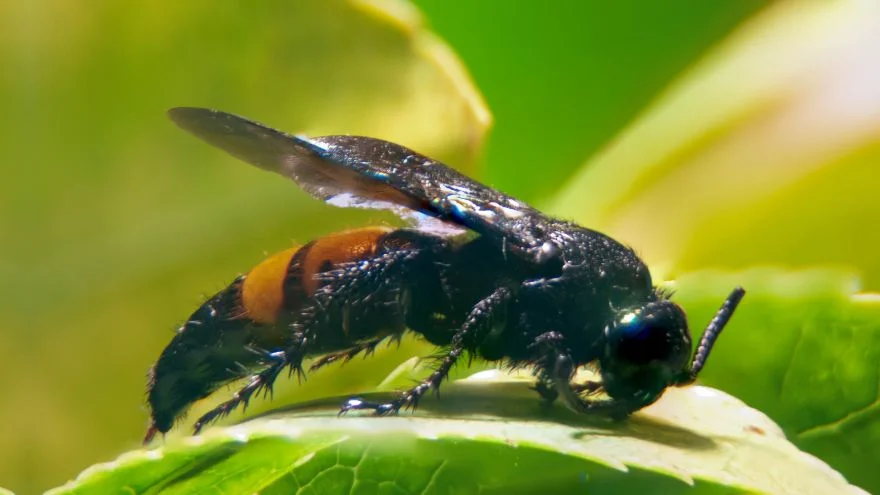The Philippines is an archipelago country in Southeast Asia known for its abundance of beautiful beaches and delicious fruits.
The country has a mild climate, friendly culture, and hospitable, family-oriented people.
While all these features make the Philippines an ideal vacation destination, all is not perfect in this paradise, as some dangerous animals roam the country, which you should know about.
The most dangerous animals in the Philippines include the Philippine cobra, crocodiles, tarsiers, bull sharks, titan triggerfish, and mosquitoes, among many others.
This article discusses the top 12 deadliest animals in the Philippines, and number 10 will surprise you!
You’ll also get crucial safety advice that you should abide by during your next visit to the country.
The 12 Most Dangerous Animals in the Philippines
1. Philippine Freshwater Crocodile

- Scientific name: Crocodylus mindorensis
- Habitat: Lowlands, freshwater rivers, ponds, and marshes
- Threats to humans: While it does not see humans as prey, it will bite in self-defense.
The Philippine freshwater crocodile is a highly endangered crocodilian species still found in the Philippines.
Although these reptiles were originally common throughout the country, they are now only found on Dalupiri, Luzon, and Mindanao islands in limited, fragmented habitats.1
Philippine freshwater crocodiles mainly inhabit freshwater marshes, ponds, and rivers.
They can be recognized by their heavily armored body covered in golden brown and black markings.
They also have a very broad snout.
These freshwater crocodiles are smaller than other crocodile species, with females being smaller than males.
Thanks to their narrow jaws, you can easily distinguish the Philippine freshwater crocodile from its saltwater counterpart (Crocodylus porosus).
Philippine freshwater crocodiles are carnivorous reptiles that eat fish, lizards, crabs, snails, and other smaller creatures.
They will only consider attacking humans if they are being harassed.
Depending on the situation, they will flash their bright yellow or orange tongues as a social cue or warning indicator.
It is advised to stay away from a Philippine crocodile if you see one.
Although they rarely attack people, they are known to be would-be man-eaters.
2. Philippine Cobra
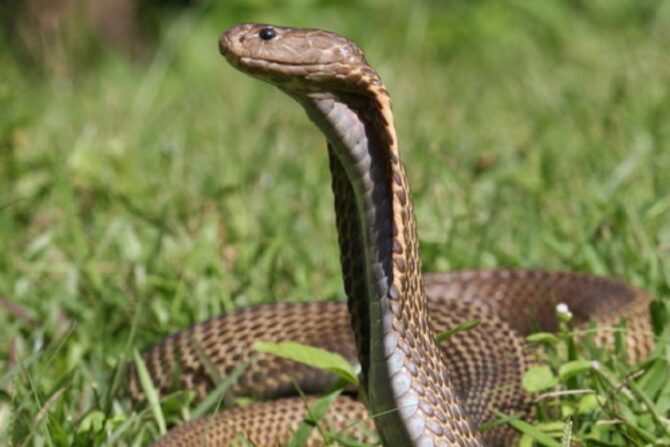
- Scientific name: Naja philippinensis
- Habitat: Low-lying plains, forests, open fields, vegetation, dense jungle, and human settlements
- Threats to humans: Poisonous spit that can cause blindness and venomous bite that can kill a human in 30 minutes
The Philippine cobra is also known as the Philippine spitting cobra.
Its name derives from its temperament and special ability to spit venom into the eyes of its aggressors with high accuracy.2
The venom is emitted through glands located at the tip of its fangs.
It is almost always aimed at the enemy’s eyes to immobilize them through temporary or permanent blindness.
The Philippine cobra can be found on Luzon, Mindoro, Catanduanes, Azria, and Masbate islands in the Philippines.
They reside in various environments, including urban areas, dense jungles, lakes, ponds, rivers, forests, and agricultural areas.
This snake species is quite stocky in build, with a typical length of about 3.3 feet (1 meter), while some specimens have been found in more remote areas to grow as long as 6.6 feet.
The Philippine cobra can be recognized by its elliptical-shaped head, dark brown eyes, rounded snouts, and large noses.
This snake also has a series of extended ribs on its neck and an inflatable hood behind its head.
When in danger, the snake can extend this hood by taking in more air.
The flap of skin stretches outward, making the snake appear larger than it is.
It does this to look intimidating or terrifying to its predators.
The Philippine cobra’s venom contains extremely potent neurotoxins that can kill a victim within 30 minutes of being bitten.
It also causes nausea, vomiting, paralysis, respiratory failure, and overall shutdown of the major organs.
Since Philippine cobras are terrestrial snakes that spend most of their time on land, hidden in bushes, rocks, and vegetation, you should take extreme caution the next time you find yourself in the Philippine wilds since there may be cobras lurking nearby, ready to ambush you.
Though aggressive, this cobra species tends to avoid human contact and is rather timid.
Unfortunately, local farmers in the Philippines who unintentionally or purposefully venture too close to cobras usually get bitten.
However, if you do come across one, make sure to keep your distance and keep a watchful eye on the ground.
You can also be shielded from the cobra’s poisonous spit by donning safety sunglasses.
3. Box Jellyfish

- Scientific name: Chironex fleckeri
- Habitat: Tropical and subtropical seas, warm and coastal waters, and shallow, murky saline waters
- Threats to humans: Nematocysts that inject a poison that can cause paralysis, cardiac arrest, and, in extreme cases, death
Box jellyfishes, also called sea wasps, are extensively found in the oceans of the Philippines.
They are distinguished by their squarish blue box-shaped body from which their name was derived and venomous stings.
Box jellyfishes are considered the deadliest and most dangerous jellyfish in the world, and they live up to this reputation.
Anecdotal evidence suggests dozens of people and perhaps more than 100 or more die each year from the many species of box jellyfish that exist in all oceans.
Since 1884 at least 5,567 deaths have been attributed to this marine animal.3
According to the U.S. National Science Foundation, the Philippines suffers 20 to 40 fatalities yearly from box jellyfish stings.4
With tentacles covered in stinging cells, these sea wasps navigate the waters of the Philippines casually.
Their stinging cells are known as nematocysts and contain a load of poison that, when released, can kill humans within two to five minutes.
Venom from the notorious box jellyfish is among the deadliest in the world, as it contains toxins that harm the heart, neurological system, and skin cells.5
Human victims have been known to go into shock, drown, or pass away from heart failure before even reaching the shore due to the excruciating pain.
Survivors often have deep scarring and can experience severe pain for weeks.
You will experience severe stinging pain and itching as soon as these tiny marine creatures’ tentacles touch your flesh.
If you’re swimming in the Philippine waters and suddenly start struggling to breathe, chances are that you have been stung by a box jellyfish.
Below are some places in the Philippines where box jellyfish attacks have been recorded:
- Sibonga, Cebu
- Malalag, Davao del Sur
- Lingayen, Pangasinan
- Caramoan, Camarines Sur
- Subic, Zambales
4. Bull Shark

- Scientific name: Carcharhinus leucas
- Habitat: Shallow coastal waters and estuaries
- Threats to humans: Aggressive nature and death from an attack
The waters of the Philippines are home to about 200 different shark and ray species,6 making it one of the world’s top shark hotspots.
However, the bull shark is regarded as the most dangerous in the nation due to its two rows of serrated chompers well adapted for ripping and tearing the flesh of prey.
This shark has been known to attack hippos, land animals weighing up to 1.5 tons, with some males growing up to twice that weight.
Bull sharks are known to be irritable, territorial, and highly aggressive, and they are usually sighted in the Philippines.
This shark species is particularly deadly since it prefers to live in shallow waters near the shore, unlike most other sharks.
Its typical patrol grounds range in depth from 60 to 100 feet.
Bull sharks may also swim up rivers and thrive in freshwater rivers and estuaries, so avoiding saltwater won’t save you from them.
Although the records of bull shark attacks aren’t so many, it takes only a little investigation to discover just how terrifying these predators are.
Therefore, you might want to look out for dorsal fins the next time you visit the beach in the Philippines.
5. Scorpion

- Scientific name: Scorpiones
- Habitat: Intertidal zone, snow-covered mountains, deserts, logs, rocks, trees, bushes, and walls
- Threats to humans: Its sting can cause intense pain, numbness, and swelling.
The Philippines is home to 16 types of scorpions, most of which reside in woodlands and forests and are rarely observed by tourists.
However, encounters do happen and are becoming more frequent, particularly in the country’s more remote regions, like Palawan, Siargao, and the hinterland of Cebu.
Although it is generally best to avoid them, scorpions won’t strike unless you injure them.
The fact that scorpions are venomous is indisputable.
While most scorpions can’t kill humans, their stings can lead to excruciating localized swelling and irritation.
Scorpions cannot kill humans; however, they can attack humans and inflict very painful localized swelling and inflammation.
A good example of a scorpion with an excruciating sting is the Asian black forest scorpion.
Although scorpion stings are rarely fatal, getting medical help is crucial if you become a victim, especially if you have allergies.
Fortunately, most of the scorpions in the Philippines are harmless, even though there are a few poisonous species.
While they might not be as deadly as their African cousins that have frequently been known to kill humans, they still pose a great threat to humans.
6. Philippine Tarsier

- Scientific name: Carlito syrichta or Tarsius syrichta
- Habitat: Tall grasses, bushes, bamboo shoots, small trees, rainforests
- Threats to humans: Painful, poisonous bite
One tarsier species unique to the Philippines is the Philippine tarsier, locally referred to as mawumag.
This animal is native to the islands of Bohol, Samar, Leyte, Maripipi, Siargao, Basilian, Mindanao, and Dinagat in the southeast of the archipelago.
Tarsiers are odd little creatures. They are one of the tiniest primates ever discovered, no bigger than an adult man’s hand.
Tarsiers derive their name from their extraordinarily long “tarsus” or ankle bones.
The tarsier’s lower tibia and fibula are joined together, serving as a shock absorber, which is normal among quadrupeds.
The length of the lower limbs is double that of the trunk, allowing the tarsier to leap from tree to tree at a distance of about three meters.
It moves in a manner resembling a frog.
The species is likely one of the oldest land species still living in the Philippines and is thought to be 45 million years old, having originated in the early Eocene period.
In captivity, tarsiers get stressed by various activities, like camera flashes or being stroked and housed in enclosures.
As a result of this stress, these primates often commit suicide7 by hitting their heads against hard objects, which kills them because of their delicate skulls.
The eyes of a Philippine tarsier are 16 mm in diameter, earning it its superb night vision.
The Philippine tarsier weighs between 80 and 160 grams; it has gray fur and a 233 mm tail that is almost completely hairless.
Despite their small size, these animals are considered one of the world’s most dangerous and venomous animals.
Tarsiers secrete a toxin from a gland in their arm, which they combine with their saliva when threatened to deliver a potent venom to predators.
7. Blue-Ringed Octopus

- Scientific name: Hapalochlaena lunulata
- Habitat: Crevices, under rocks, shallow intertidal marine waters
- Threats to humans: Highly potent venom that is painless but can cause respiratory problems, paralysis, and, eventually, death
The blue-ringed octopus is native to the coral reefs and shallow seas around Australia and Southeast Asian regions, including the Philippines.
They can be recognized by their characteristic blue and black rings, which change color dramatically when the animal is threatened,8 and their yellowish skin.
At first glance, this dazzling, vibrantly colored octopus may seem intriguing and alluring, but don’t let this fool you into thinking it is harmless.
In reality, these hues are meant to frighten away potential predators.
So, those colors may easily be the last thing you see before coming under attack from these incredibly toxic and venomous sea monsters.
Blue-ringed octopuses get provoked when handled despite their small size(12 to 20 cm) and generally docile demeanor.
They are listed among the most poisonous aquatic animals on the entire globe.
The venom of blue-ringed octopuses contains tetrodotoxin, a potent neurotoxin estimated to be more potent than cyanide), which is very deadly to humans.
A blue-ringed victim attack can quickly cause organ failure and total body paralysis in the creature.
Since their bites are small and frequently painless, many victims of this octopus don’t realize they have been envenomated until respiratory depression and paralysis set in.
Although the blue-ringed octopus is generally a peaceful creature that avoids confrontation, it will attack if it feels threatened by a person.
8. Yellow-Lipped Sea Krait

- Scientific name: Laticauda colubrina
- Habitat: Along clean shores, open seas, shallow coastal waters
- Threats to humans: Highly potent neurotoxic venom
The yellow-lipped sea krait, also known as the banded sea krait or colubrine sea krait, gets its name from the color of its nose.
This venomous snake is an aquatic reptile that can be found in the tropical Indo-Pacific.
The snake features striking black stripes, a yellow nose, a paddle-like tail for swimming, and distinctive black spots on its body.
Don’t be fooled by the fact that yellow-lipped sea kraits don’t have the same biting statistics as cobras and venomous snakes.
When threatened, they can still cause as much harm.
These sea kraits frequently come into contact with people since they spend so much time on shore.
They have been discovered in boat exhaust and water intake pipes.
Yellow-lipped sea kraits are drawn to light and can be distracted by artificial lights such as those from hotels and other structures along coastlines.
The banded sea krait spends most of its time hunting underwater, then returns to land to eat, rest, and spawn.
It uses its very poisonous neurotoxic venom to feed on small fish and eels.
Since sea kraits are both land and sea snakes, they frequently surface to breathe.
If you don’t want to have a close encounter that could be fatal, make sure you don’t linger above them while they swim upward to seek air.
9. Centipede
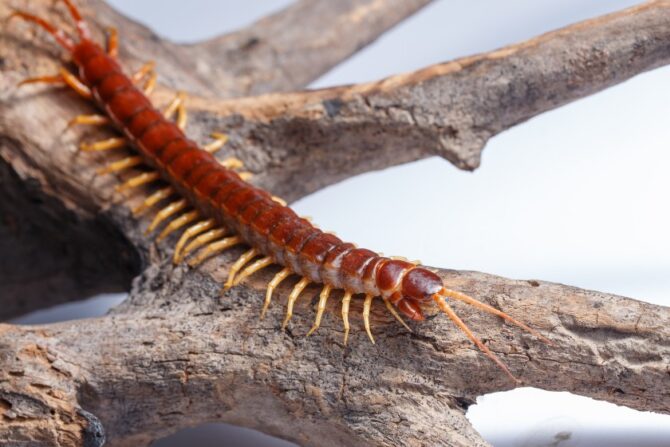
- Scientific name: Chilopoda
- Habitat: Logs, the bark of trees, mulch, stones, inside trees and caves, rainforests, deserts
- Threats to humans: Intense pain, swelling, and, in rare cases, death
Centipedes are one of the biggest terrestrial invertebrate predators.
These arthropods play a major ecological role by contributing to the biomass of invertebrate predators in terrestrial habitats.
At first glance, the common centipede may not raise any alarms.
However, giant centipedes are among the most venomous and dangerous creatures you might encounter in the Philippines.
Two examples of giant centipedes are the orange-legged centipede and the jungle centipede.
All centipedes are poisonous and can deliver painful bites by injecting their venom through forcipules, which resemble pincer-like appendages.
In 1932, a seven-year-old girl was reported to have died after being bitten on the head by a centipede in the Philippines.9
10. Stray Dog

- Scientific name: Canis lupus familiaris
- Habitat: Residential areas
- Threats to humans: Aggression, ferocious bite, and rabies
About 12 million stray dogs are estimated to be living in the Philippines.
The locals have a specific word for stray animals because they are so prevalent in the area.
They call them askals, which refers to the native breed of dog found throughout the nation, from Davao to Palawan.
Stray dogs can sometimes be vicious and aggressive, putting you at risk of injury.
They can also carry various diseases, including rabies, which is prevalent in the Philippines.
We advise that you maintain a safe distance from any stray dogs you come across.
If you want to visit the rural areas or handle any stray dog, make sure you are up to date on your rabies vaccinations.
11. Titan Triggerfish

- Scientific name: Balistoides viridescens
- Habitat: Shallow coastal environments (lagoons and reefs) and tropical and subtropical oceans
- Threats to humans: Painful bite
The Titan triggerfish is a fearsome fish that lurks just below the surface of the waters near the Philippines.
Its bite is excruciating, thanks to its enormous, sharp teeth.
This fish is often considered a solitary marine animal that can grow massively.
However, due to its aggressive character, it is a nuisance to snorkelers and divers in the sea.
Titan triggerfishes are renowned for being highly violent and possessive against both humans and sea animals.
Despite not being a poisonous sea creature, this fish can inflict a lot of harm if they decide to attack.
You are most likely to be attacked by a titan triggerfish if you swim on top of one of their nests.
Their territory forms a cone-shaped upward extension, so avoid swimming upward because you will still be in its domain.
Your best line of action is to swim outward away from the nest if you unintentionally swim into their area.
When you spot a titan triggerfish nearby, swim away immediately or avoid its route.
As you swim away from the titan triggerfish, ensure you never lose sight of it to avoid being attacked from behind.
12. Mosquito
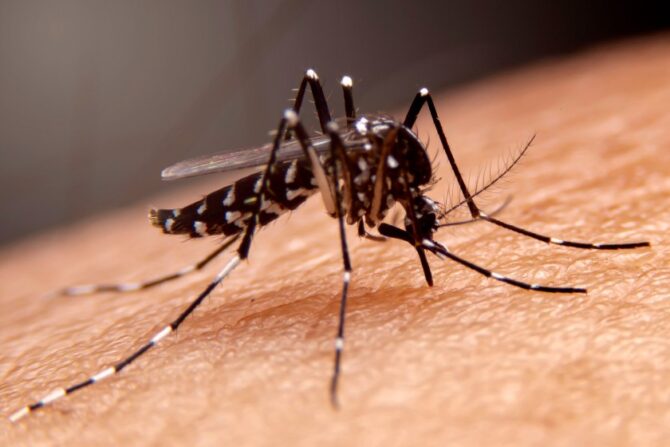
- Scientific name: Culicidae
- Habitat: Water, forests, plants, trees, tall grasses, artificial structures, ponds, swamps, marshes
- Threats to humans: Diseases like malaria, dengue, and filariasis.
Tropical nations like the Philippines continue to experience serious issues due to diseases spread by mosquitoes.
Mosquito bites are very common among humans because the insects are small and can fly.
That’s why everyone must safeguard themselves against the threat mosquitoes pose.
Mosquitoes are one of the most prevalent carriers of tropical diseases like dengue and malaria.
Each year, these diseases kill thousands of people in Asia and Africa.
Unfortunately, mosquitoes are a common sight across the Philippines.
They can flourish on almost every island in the nation because of the hot, tropical climate.
Precautions you can take include covering up at dark and dawn, using anti-mosquito bands, carrying a strong DEET spray, and hanging a net over your bed.
Below are other dangerous animals in the Philippines that you should be aware of:
- Fire coral
- Fireworm
- Stargazer
- Cone snail
- Sea urchin
- Crown of thorn
- Widow spiders
- Jumping spider
- Coral snake
Philippines Wildlife Safety Tips
If you visit the wildlife in the Philippines, be sure to take all necessary precautions and obey all rules because some are not meant to be broken.
This is especially true when you’re in the natural habitat of wildlife and near ferocious wild animals.
It would be best if you abide by the following safety guidelines:
1. Avoid Feeding Wild Animals
It’s normal to be enthralled by an animal’s seemingly friendly behavior and want to feed it, but this can be the biggest mistake you’d ever make.
Feeding wild animals can make them reliant on “human food.”
As a result, they may become aggressive toward bystanders when hungry and unable to find food.
2. Avoid Close Animal Encounters
Since even the most placid-looking animal can become violent, it’s best to avoid close wildlife encounters.
Wild animals are not pets; they are capable of more rage, strength, and violence than you can imagine.
You can’t always tell which animal is dangerous from its appearance, so always avoid wild animals.
3. Take Caution
Many of the animals listed in this article enjoy the darkness, so exercise extreme caution at night and when in dark areas.
Also, sim only in regions free of sharks, crocodiles, and other harmful marine life.
Frequently Asked Questions
What Is the Most Dangerous Animal in the Philippines?
The Philippine cobra may be the most dangerous animal in the Philippines due to its natural abundance throughout the nation and the potency of its venom.
Bull sharks and freshwater crocodiles are also two deadly animals that may be found in the Philippines, both on land and at sea.
Do the Philippines Have Poisonous Snakes?
The Philippines has a large number of poisonous snakes.
Besides the Philippine cobra, the king cobra and yellow-lipped sea krait are two very venomous snakes whose venom can kill humans.
Though the reticulated python is a non-venomous snake, it is still a formidable predator in the Philippines.
This snake crushes its prey to death before swallowing it whole.
Are There Dangerous Spiders in the Philippines?
The Philippines is home to many harmful spiders.
Travelers who are arachnophobic should take extra precautions when visiting these islands because they are home to the fearsome black widow spider, whose deadly bite has the power to injure or even kill a human severely.
Conclusion
The Philippine cobra, freshwater crocodile, tarsier, and bull shark are some of the most dangerous animals in the Philippines.
The next time you visit the Philippines, it’s important to avoid these creatures to protect yourself from harm and even death.
References & Notes
- Philippine crocodile. Smithsonian’s National Zoo
- Southern Philippine Cobra. Ecology Asia
- How jellyfish sting. National Sea Rescue Institute
- Jellyfish Gone Wild. National Science Foundation
- Box Jellyfish. National Geographic
- Shark Research and Conservation in the Philippines. LMVRI
- Tarsier. Endangered Species International
- The blue-ringed octopus: small, vibrant and exceptionally deadly. National History Museum
- Centipede Envenomation: Bringing the Pain to Hawai‘i and Pacific Islands. National Library of Medicine

